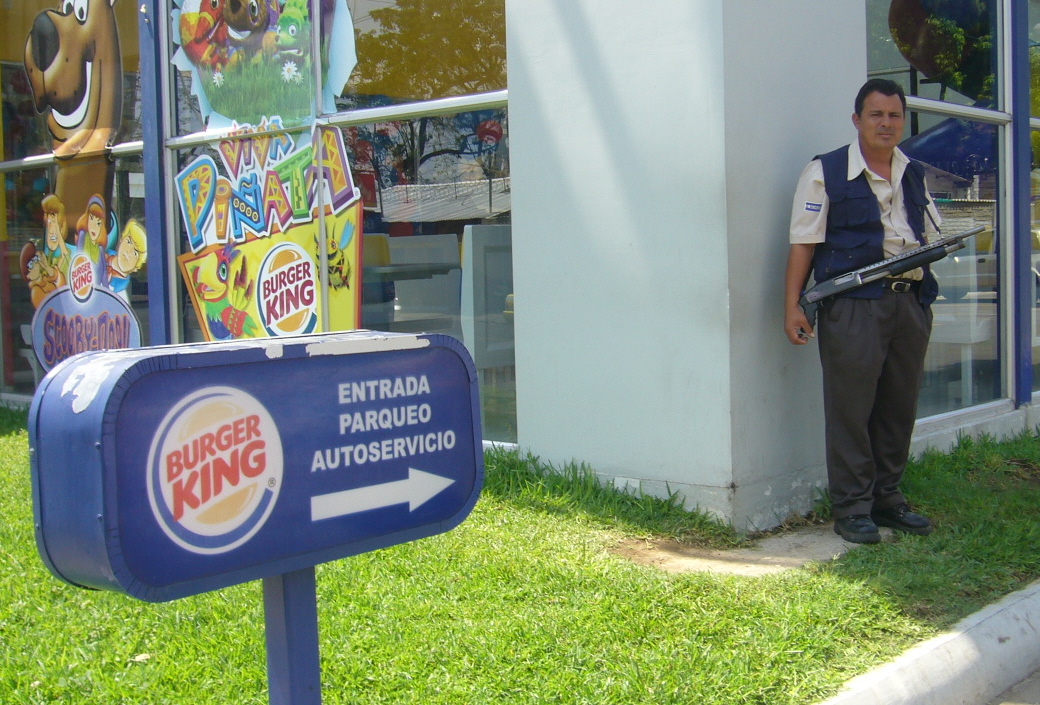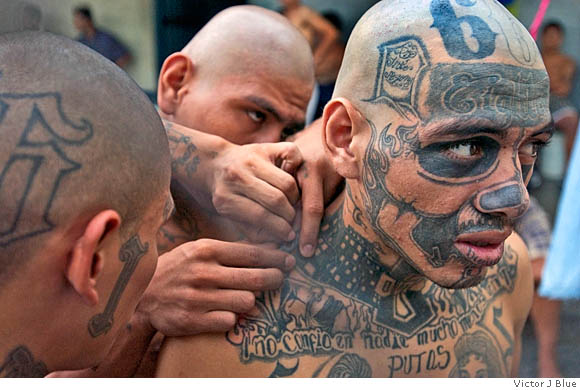I did not see much of El Salvador, mainly because I wanted to spend more time in Honduras, but also because I got sick yet again. I was laid up for two days with diarrhea, fever and exhaustion. Not sure what the culprit was this time; I must have ate something bad again. It seems to happen every 3-4 weeks. I hope it’s nothing serious like you see on National Geographic channel.
My dad had a few parasitic adventures as well while bushwhacking his way through the Costa Rican jungles in the 1960s looking for pre-Columbian graves. You can read about one of them here. It starts, “one day, years ago, while in Costa Rica, I had a bowel movement.” It only gets better.
Despite the delay I was healthy enough to make it to San Miguel and San Salvador. One thing you notice about El Salvador: they have a robust security industry. There are security guards with shotguns everywhere. Even at fast food joints:
The people are very friendly. They stare at me, like everyone else, but at least they wave and say hello. the kids loved me. I stopped for a drink at a small store and this group surrounded me. Shy, but so curious about this sweaty white guy on his overloaded bicycle.
There’s a lot of garbage in El Salvador. More than most countries in Latin America, which is saying a lot. We’ve touched on this subject before so I won’t belabor it. The government is trying to encourage people to stop throwing trash, as evidenced by the photo below, but it does not seem to be very effective.
“Don’t throw trash. Keep our roads and highways clean”. A fine of $500 is threatened.
Here are a couple views on the way to San Miguel:
In San Salvador I took a walk and got lost in a maze of small backroads. It felt wierd as people stared at me like I did not belong there. Maybe I was being paranoid. I can’t imagine it at night.
El Salvador’s Bloody History
In many ways the history of El Salvador is similar to the rest of Latin America. The Spanish came, they wiped out the indigenous people, established a hierarchical society, and oppressed the majority of people so the few could exploit the many. Each country has its own horrific past, but in El Salvador, they really overdid it. The richest 2% of the population had like 95% of the wealth. Now I don’t believe that in itself is bad, but if it is obtained by oppressing the majority, then it’s plain wrong.
This imbalance naturally led to resentment among the peasants and rural poor. Finally in 1932 a guy named Farabundo Marti led a peasant uprising, which was quickly put down. The military responded by systematically killing anyone who looked or sounded indigenous, or who had supported the uprising. In all, 30,000 were killed in what became known as la matanza (the massacre).
After la matanza things just got worse. Over the next 30 years, the poor got poorer and the rich got richer. The country was run mostly by a ruling oligarchy in alliance with military forces. But peasant opposition continued, and guerrilla activity increased, so the military responded by creating the infamous “death squads”, which were primarily military or paramilitary units carrying out political assassinations and torture. The peasant groups eventually coalesced into the Farabundo Martí para la Liberación Nacional (FMLN). Meanwhile, the USA was funding the military to the tune of billions of dollars.
The conflict dragged on for 12 years before I guess everyone got tired of fighting and they signed a peace agreement. But not before 75,000 people, mostly poor peasants and indigenous people, had lost their lives. 300,000 fled the country and America spent over $6 billion. I’m glad to know my tax money was well spent. Argghh.
The FMLN is now a legitimate political party
But he war’s legacy continues. Those 300,000 displaced people? Many went to the USA, mainly Los Angeles, and their children became the roots of the violent gang Mara Salvatrucha, aka MS-13. You may have heard of these guys. The gangs were created to defend the Salvadorans from other Latino gangs in the area, mainly Mexican. When LA cracked down on the gangs and deported many members back to El Salvador, they continued to thrive in a country with weak police and lots of guns. They are known for their extensive tattooing and violent attacks, including gruesome decapitations, mainly on other gang members. They tend to hang out in certain areas of San Salvador, and although tempted, I decided not to ride through them.
This is not my photo, but Here’s what some of the gang members look like. If you see a guy like this, run the other way.
Today El Salvador has one of the highest per capita murder rates in the world — 59 per 100,000 in 2005, (By comparison the murder rate in New York City was 7 per 100,000). Income inequality still persists but is improving. I hope they can get it right peacefully this time.

